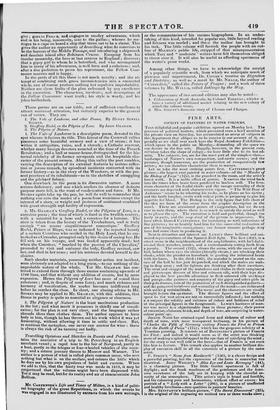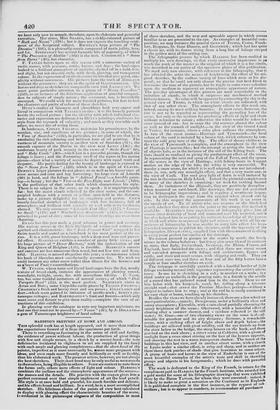FINE ARTS.
SOCIETY OF PAINTERS IN WATER COLOURS.
THIS delightful and popular exhibition opened on Monday last. The pressure of political matters, which prevented even a brief mention of the private view on Saturday, has accumulated au asserts of subjects in this department that obliges us to be concise in our account of it, es- pecially as we shall next week have the Royal Academy Exhibition— which opens to the public on Monday—demanding all the space we can devote to the fine arts. Happily, however, in the present case, criticism takes the shape of eulogy—we have little else to do but ad- mire. The subjects, too, ure for the most part of the simplest class— landscapes of Nature's own composition, and rustic scenes; and the pictures, though numerous, ure the production of comparatively few artists; we can therefore characterize them in masses. Let us take the most striking points first. CATTERMOLE'S great picture—the largest ever painted in cuter colours—of the "Murder of the Bishop of Liege" (125), is the grandest in the room, and the artist', finest work. It is a noble effort of genius. It carries the mind back into the times when brute force pandered to lawless will. The fero- cious character of the feudal chiefs and the savage sensuality of their retainers are depicted with characteristic vigour. " The Wild Boar of Ardennes" seems to be whetting his tusks, us he glares on his victim; and the burly burgher, swoln with vulgar pride' is preparing to glut his appetite for blood. The Bishop is the only figure that falls short of the idea we form of the scene from the graphic description in the novel. There are occasional points of exaggeration, but we do not care to note them, where there is so much to satisfy the mind as well as to please the eye. The execution is bold and powerful, though too hasty in parts, and the coup itwil of the picture is impressive. We have often blamed C. vii for tantalizing us with indications of fine pictures; we as heartily laud hint for this successful realization of one of his imaginative conceptions ; our former censure perhaps may have had some share in producing it.
Next in attraction and interest are LEWIS'S three brilliant and ani- mated representations of the Spanish Bull fight. The first (302), is a street scene in the neighbourhood of the amphitheatre, with WA-light- ers and their wenches, monks, and a contrabandista setting forth from
2 a posada. The second (11), shows the arena, with the onset of the
hull, before whose eyes the chubs (literally cheats,) are whisking their cloaks, while the picador on horseback is goading the infuriated brute with his lance. In the third (143), the matador is seated on the car- case of the bull he has just despatched, and which the mules are wait- ing to drag away ; and the fighters are drinking after their exertions. The strut and swagger of the matadures and chulos in their sumptuous and picturesque dresses of blue and crimson silk, with their legs dis- played to the best possible advantage in flesh. coloured silk stet:kings and pumps—the pertness and coquetry of the gipsy and other girls in theirgala dresses, vain of the protection of such distinguished gallaets- and the pampered indolence and sensuality of the monks—are delineated with strakir g verisimilitude. The scene and the characters are vividly brought before the spectator. The distant figures and the effect of space iii the vast arena are not so successfully indicated ; but nothing c .n surpass the solidity and richness of colour and boldness of relief of the principal figures in the foregrounds. Lawis's hardness of man- ner was never less objectionable than in these pictures; their power of execution, elaborate finish, and depth of tone, are surprising in water- colour paintings. JOSEPH NASH has attained equal force and richness of colour and depth of tone, with more transparent brilliancy, in his picture of " Charles the Fifth of Germany visiting Francis the First in Prison after the Battle (f Pavia" (175); which has the gorgeous sobriety of a Venetian painting. It reminds us of BONINGTON'S picture of Francis the First : and indeed it would seem as if the artist was thinking more of making a splendid appeal to the eye than of satisfying the mind ; for the story is not well told in the faces—that of Francis is not even like him in feature. This remark also applies to another brilliant dis- play of executive skill in all the externals of a picture by the same artist.
F. STONE'S " Scene from Kenilworth" (156), is a clever design and a powerful painting, but the expression of the faces is somewhat too theatrical. JOHN Wale wr's " Alice Lee and Louis Kerneguy" (44), is a charming picture. The little Gothic apartment is full of daylight ; and the frank manliness of the gentleman and the femi- nine sweetness of the lady arc in keeping with the cheerful se- renity of the atmosphere. This artist's style is broad and forcible, and his colouring pure and harmonious, without effort or excess: his portrait of a "Lady with a Letter" (286), is a picture of unaffected and healthy loveliness—rare qualities in painters' beauties.
Mrs. Sevensant's brilliant picture, " The Secret Discovered" (25), is the original of the engraving we noticed two or three weeks since; we have only now to remark, therefore, upon its elaborate and powerful execution. Her sister, Miss Susan:, has u richly-coloured picture of
"Ruth and Naomi" (178) ; but it does not express the touching senti- ment of the Scriptural subject. Riciersies large picture of " The Dromios" (191), is a pleasantly-comic compound of rustic jollity, love, and fat. STEPHANOFF has several fantastic bits of pageantry, of which " The Procession of Aladdin" (102) is the best. CHISHOLME.S " Scene from Burns" (48), has character. F. TAY LER bursts upon us this season with a numerous variety of rustic scenes, with peesants, cattle, horses, and dogs ; the landscapes bathed in a brilliant atmosphere of sunlight—dashed off in a bold, free, and slight, but not slovenly style, with fresh, glowing, and transparent colour. In the expression of rustic character he hits that nice point, sim- plicity without coarseness. His pictures have the truth of Monsatso without the grossness: they are in the spirit of G A I NSBOROUGH. llis horses and dogs us sketches are comparable even with LA NDsE E II'S We must point particular attention to a group of " Ilear9 Trarellers" (253), as an instance of the felicitous application of graceful composi- tion to subjects of simple nature ; the sentiment, too, is beautifully conveyed. We eould wish for more finished pictures, but fear to lose the clearness and purity of colour of these sketches. HUNT'S studies of labourers and ploughboys look very course and literal in comparison with TAILER'S rustics : it is the homely portrait beside the refined picture : but the identity with which individual cha- racter and expression are delineated in Ilusa-s paintings, vindicates his style from the reproach of vulgarity; and much us they resemble each other, we never tire of seeing them.
In landscape, COPLEY FIELDING maintains his preeminence, by the number, size, and excellence of his pictures ; in some of which, the " View if Snowdon" (116), in particular, we arc glad to see that he is emulating the rich colouring and brilliant tone of oil painting. The vastness of mountain scenery in another view of Snowdon (91) ; the smooth expanse of the Downs in the view near Lewes (1311) ; the verdurous beauty of park scenery in the views of " Stoke Park" 10), and " Roby Castle" (30)--wheel last is a powerful picture, though the foliage is heavy ; and the fluctuating swell of the waves in his marine pieces—shOw what a variety of scenes he depicts with equal truth and elegance. His poetic feeling for the beauty of landscape is evinced in the " Scene from Tasso" (123), which is in the spirit of C LA UDE. DEWINT'S larger pictures do not please us so well as his lesser ones of river scenes and corn and hay harvesting: his large view of Lincoln .(90) is hard, and the foliage in " Ashtead Forest "—a forcible paint- ing—is lumpy ; but the " View on the Fuss Dyke, near Lincoln" (129), is the perfection of that sober truth which characterizes his style. There is no subject in the scene, so to speak : it is unpicturesquely flat : but the moist clouds reflected in the clear water, and the em- purpled herbage with a streak of yellow corn-field in the distance, make up a picture delightful for its simplicity and power. Cox's loosely-touched sketches of landscapes with low horizons, full of atmosphere, and brilliant with sunlislit or cool with dewy freshness, abound. We only enumerate "Ederside Peat Mims" (Ili)," Lancas- ter Sands" (119), and " mar Kenilawth" (147), as being the principal in point of size; some of his smaller drawings are even inure charming.
EVANS has this year made a great advance in power and mastery. his various scenes ill the Irish highlands of caldils and cotters are spirited and characteristic : the " frisk Peasant Girl" wrapped in her freize mantle and seated on a rush-track is the most perfect of the se- ries. It is a wild, green landscape, with a deep cool tone and pou cr. ful effect. GASTINEAU exhibits a number of pretty little views ; and his large picture of " Dover Harbour," with the embarkation of the King and Queen of Belgium (159), is forcible. Banes:TVs sunsets and sunrises are less numerous than usual, but not less true and beau- tiful. HARDING is missed altogether this year; a circumstance which his book of Sketches most satisfactorily accounts fins We wish we could instance any other cause rather than illness for the fewness and an :Illness of Paocr's contributions.
W. TURNER, whose tame and literal landscapes have the flat, woolly texture of broad-cloth, imitates the appearances of glowing sunset,
moonlight, twilight, snow, ice. with marvellous fidelity. F. NASH, WO, has sotne truthful imitations of natural scenes ; of which "Dale Turnpike Road" (75), is the most perfect. NESIIELD'S views in Arran and Bute ; some Cuyp-like cattle pieces by TH A LES FIELDING ; CHAMBERS'S fresh and breezy river and sea pieces ; oxen and deer—which seem painted in imitation of needle-work; Scorr's pic- turesque cottages; and BARTHOLOMEW'S fruit and flowers—which only want scent and flavour to give them reality—complete the sum of at- tractions of this exhibition.
In glancing over the catalogue to note any important omissions, we find one that must not be passed by—" Venice" (37), by J. HOLLAND— gem of Turneresque brightness of local colour.



























 Previous page
Previous page